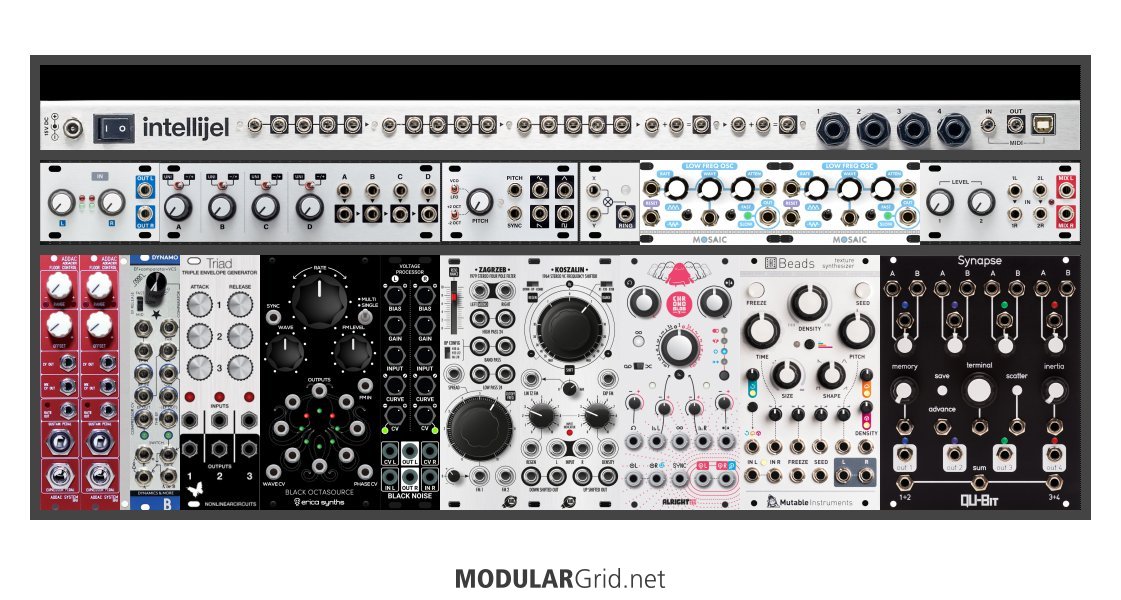Well, I didn't get this to fit in 64 hp...but you might want to have a look anyway...

Bigger makes this work. Here's what's there...
First up, I went with an Intellijel Palette 104 so as to keep this build gig-bag-able. This also gives you a set of buffered mults and some adders, along with the four 1/4" I/O jacks, and it contains your power supply. The buffered mults in this case can be used to mult-out a stereo pair to three outputs (using two mults, natch), leaving a third for modulation routing.
The tile row here is pretty significant as well. Your stereo inputs are on the left (fed by a pair of the 1/4" jacks), then a QuadrATT lets you mix modulation, or you can use it as a mono mixer...or both, since you can "break" the output bus into a pair of two-channel outs. This also gives you the ability to attenuvert various modulation sends, it functions as a DC offset source...very useful thing. Next, you'll note the VCO right next to a ring mod tile; the VCO is the ring mod's "carrier", offering four waveforms. Plus, that VCO can be dropped into low frequency rates...so, send a slow square wave in one side, the guitar in the other, and voila! Instant "Crimson and Clover" audio chopping! After those are two more utility LFOs...both of which have wave restarts, which is also important here (you'll see why in a bit). Then the output mixer lets you separate two different mixes and then combine them when going into the outputs (the other two 1/4" jacks). This should function as a very capable wet/dry control...run your dry signal (or maybe the wavefolder output?) into pair #1, your FX mix into pair #2, adjust as desired.
The MODULE row, though...that's where things get interesting!
First up is a pair of ADDAC 301 pedal interfaces. These have an expression pedal input as well as a "latch" switch for sustain...or for firing something else, such as the huge thing at the end of the row. After that, a Bastl Dynamo does double duty by providing two channels of envelope following/gates, plus an A-B switch, all under the control of the input signal's dynamics. After that, there's a trio of AR envelopes from Nonlinearcircuits and a rather twisted LFO from Erica. The Black Octasource is a single LFO...but with eight outputs, all set 45 degrees of phase from each other. With that, you can have things like autopanning, weird modulation "lumps", odd modulation "cancellations", etc. Sure, you could have four LFOs...but this thing gives you eight ways to use one LFO, all in perfect sync. The Black Noise Voltage Processor is your waveshaper...stereo waveshaper, in fact. Get used to that word, btw...from here on, the entire audio path is STEREO.
So, once you get past the waveshaper, you're into the effects. The first two are from Xaoc...their 4-pole multimode stereo VCF, followed by their CV controlled frequency shifter (also stereo). You might notice the lack of phase shifters or flangers here, and that frequency shifter is the reason. It can do those things, but it can do them to extremes; crank the shift control, and everything turns into clangers and howlers with gnarly anharmonic timbres. But turn it back down to just barely off zero, and suddenly you've got this phasing...SOUND. Nothing like 'em, really!
Then we've got an Alright Chronoblob2. This stereo delay hides a surprise: an insert in its regen path. Want to listen to things warp out of shape with each repeat? Insert the frequency shifter into the Chronoblob's regen, set the shift for a half-step, and hear the echoes whirl upward into weird aliasing. Or drop the VCF in, and degenerate the repeats, or or or... Anyway, after that is Mutable's Beads...which, if you're going to get one, you'd better hurry as Emilie is shutting down pretty much now. But if not, no prob...there's 14 hp variations on the very similar Clouds that'll drop right in if you don't get lucky.
And then, the Qu-bit Synapse. This is billed as a "crossfading switch", and it's a bit complex as to what it's capable of. But one thing that immediately comes to mind here is the fact that the Synapse can store and recall eight different settings, and you can access that via its "advance" jack. That's why the ADDACs with their footswitch capability is there, as one of those footswitches can be dedicated to that "advance" control. Otherwise, it's sort of like a variation on Mutable's Frames mix-scene module...set up your signal path, CV levels, etc etc, and store it.
So, no...I totally blew it on the form factor. But that was very deliberate on my part, because that 64 hp build was very restrictive due solely to the available space. By shifting to a Palette 104, though, I was able to toss a LOT of potential into the build...and in the end, 104 hp isn't that difficult to shlep around, especially if you pick up one of these from Intellijel: https://intellijel.com/shop/cases/gig-bag-for-4u-palette-cases/ Not too shabby, those...about the size of a violin case, actually.

